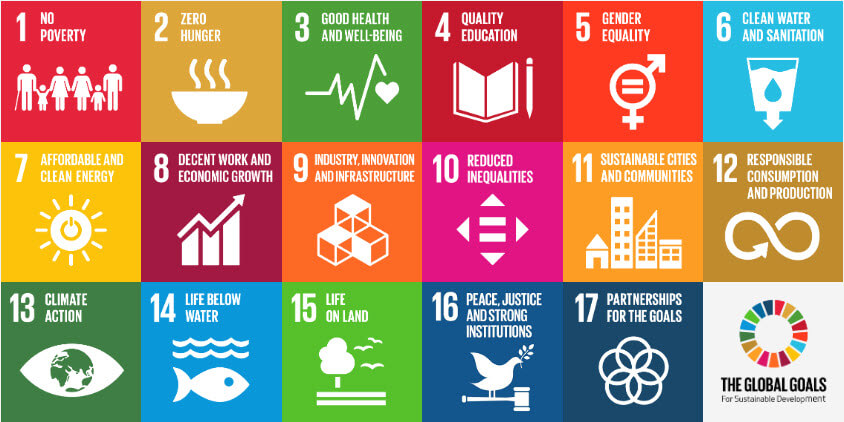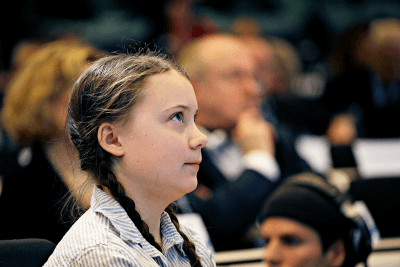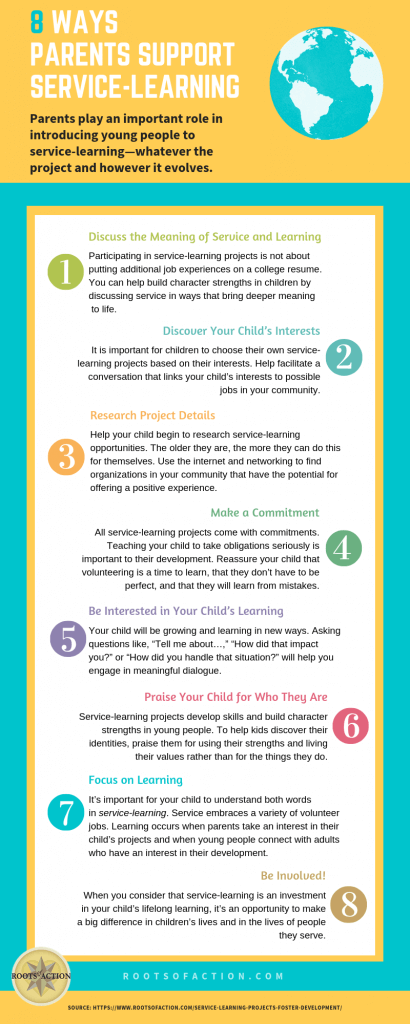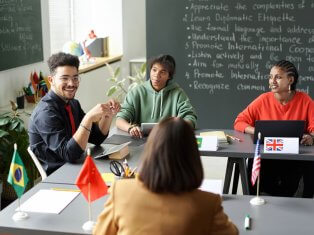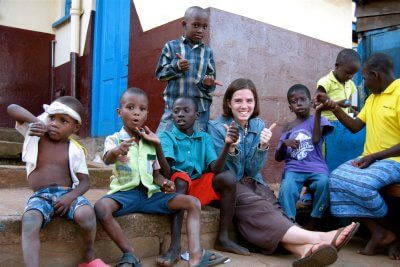
When I was a teenager, we didn’t have a term for service-learning. There were opportunities to volunteer in our communities but not many people thought about the lifelong value of such experiences.
As I reflect on my early volunteer experiences, I know for certain that my life was changed as a result of working with a group of students to help rebuild an inner-city neighborhood in Detroit that had been devastated by the 1967 riots. The positive impact of this experience was so great that I devoted a good deal of my research in positive youth development on understanding the lifelong benefits of service-learning and civic engagement.
Research shows that young people who participate in meaningful service-learning projects gain developmentally from their experiences. That’s because service and learning go together, especially in the maturing brains of adolescents. When children collaborate on service-learning projects, they grow in empathy, curiosity, self-awareness, and many other aspects of healthy development. Society benefits too.
What Is Service-Learning and Why Is It Important?
Service-learning has two elements: 1) It actively engages young people in projects that benefit their communities, and 2) It fulfills specific academic goals as set forth by schools.
Student projects that center around service go beyond traditional classroom practices or individual volunteering experiences to integrate specific learning processes, like intrapersonal reflection and critical thinking. Projects also expose young people to community settings that are more unpredictable and complex than classroom settings. Most importantly, these projects give kids a voice in creating change, the experience of working collaboratively to affect change, and a deeper understanding of themselves and others.
Service-learning projects are most often organized through schools or after-school programs and give kids the opportunity to link what they learn in the real world to what they are studying. Schools work with a variety of community and national agencies to provide these rich learning experiences to students. According to Elmhurst University, “service-learning involves almost any helping activity,” including “direct service to individuals, indirect service to people, and advocacy work.”
Recent research in the field of service-learning continues to show its value to students, schools, and communities. A 2019 study compared the valuations of students that had completed classes with a service-learning component vs. those with no service-learning, showing that the service-learning group had significantly higher levels of course satisfaction. They also reported much higher levels of learning and personal growth. A 2021 study showed how service-learning supports teacher education by helping educators connect theory and practice that enable students to support the community and build job-related skills. A 2021 study published in The Journal of Health Administration Education, showed that students who participated in an intergenerational service-learning project had significantly higher multicultural sensitivity levels than students who wrote traditional papers on ageism. When combined with hundreds of other studies, it is increasing clear that service-learning is a valuable and essential part of 21st century education.
From Empathy to Action: An Example of Service-Learning
Service-learning can take many forms. In recent years, more research-based curriculum is being developed to support teachers as they work to help students address the United Nation’s 17 Global Goals through life-enriching learning experiences for students.
Design for Change USA (DFC) is an example of one organization that provides professionally-developed service-learning curriculum to schools. It is part of a global movement in more than 65 countries that engages over 2 million young people worldwide. Founded in India by world-renowned educator and design thinker Kiran Bir Sethi, DFC facilitates projects for middle and high school students that incorporate the Global Goals.
Through a digital platform that includes podcasts to spark student discussion about relevant social issues, DFC offers detailed guides and professional development for educators. Students work in teams to investigate social issues, brainstorm solutions, develop action plans, and implement their ideas. Projects are designed to develop empathy, persistence, resilience, and more. The methodology is highly experiential, involving four stages of learning:
FEEL – Project teams gather inspiration, build empathy, and analyze an issue.
IMAGINE – Teams work with community members to frame a question, brainstorm ideas, and select the idea they want to work on. Young people use their imagination and creativity to think outside the box.
DO – Teams develop and implement their shared action plan, get feedback, and implement change.
SHARE – Teams reflect on their experience, raise awareness of their issue, and inspire action from others.
Throughout their service project, students are learning a process called “design thinking,” a solution-based approach to solving real-world problems. Some of the world’s leading companies use design thinking to spark innovation. It is taught at universities, including Harvard, Stanford, and MIT.
In a nutshell, design thinking begins with empathy. By understanding the people for whom the project is trying to benefit, young people can reframe the problem in human-centric ways. By the time a project is complete, students have brainstormed, tested, experimented with solutions, and imagined numerous ideas. They have literally transformed empathy into action.
Recent research conducted by DFC suggested students have long-lasting benefits from their service-learning projects in many of the same ways as the civically-engaged students I interviewed in my book, Tomorrow’s Change Makers: Reclaiming the Power of Citizenship for a New Generation.
A former Design for Change participant, now a college student, said, “Design for Change allowed me to be more reflective of my community engagement, but also in terms of looking at what causes a problem in a community. A lot of times, you might say, ‘Okay, there’s a lot of homeless people here,’ but DFC made us actually look at why, and being able to research and find the roots of a problem, the roots of how oppression has affected communities in the past and still today.”
This college student attributes his Design for Change service-learning project in middle-school to the work he is doing today with a low-income minority community in Michigan. He learned a way of thinking that formed a basis for making collaborative change in the world.
Design for Change USA and its affiliates around the world are good examples of how service-learning projects have deeper impact than performing other volunteer jobs where kids do not have a voice and are not part of the learning and critical thinking processes.
8 Ways Parents Support Service-Learning Projects
While service-learning is a term most often used in schools, it need not be confined to the school year—or to classrooms. Opportunities abound for rich experiences where young people can come together to work for a cause, build relationships, learn about social issues, and apply their skills in the real world.
Greta Thunberg is a 16-year-old Swedish environmental activist. She is credited with raising global awareness of the risks posed by climate change and with holding politicians accountable for their lack of action. Greta is also on the autism spectrum and considers autism her “superpower.” Whether you agree with Greta’s cause or not, she is learning what it takes to organize others, communicate about something she cares about, and collaborate on solutions, despite personal challenges. With the encouragement of her parents, you could say Greta has designed her own service-learning project!If Greta was your child, how would you support her passion to make a difference? Or if that passion wasn’t obvious, how would you help her discover her interests? Parents play an important role in introducing young people to service-learning—whatever the project and however it evolves.
Research shows that civic engagement promotes higher academic achievement and develops many skills, including critical thinking, organizing, and planning. It also helps young people form an identity, an essential role of adolescence. But all volunteer jobs are not created equal and finding the best experiences for children and teens can be challenging. In Community Service Ideas for Kids: Why Giving Back Matters, you can read how children learn to care for others and take action from elementary school through the teen years.
Here are some guidelines for supporting young people in their service-learning projects.
1. Discuss the Meaning of Service and Learning
Participating in service-learning projects is not about putting additional job experiences on a college resume. You can help build character strengths in children by discussing service in ways that bring deeper meaning to life. When children do community service as a route to college admission rather than to genuinely serve others, learning is diminished.
2. Discover Your Child’s Interests
It is important for children to choose their own service-learning projects, based on their interests. Although parents may have a great job for Billie through their friend at the local food bank, Billie may prefer to work outdoors building trails. Let go of what you think Billie should do and help facilitate a conversation that links your child’s interests to possible jobs in your community. Kids have a much greater capacity to develop purpose and initiative when they choose service-learning projects for themselves!
3. Research Project Details
Once you’ve determined your son or daughter’s interests, help them begin to research service-learning opportunities. The older they are, the more they can do this for themselves. Use the internet and networking to find organizations in your community that have the potential for offering a positive experience. Good starting places are All for Good and Summer Programs for Kids & Teenagers. If your teen wants to organize their own project, point them to VolunteerSpot where anyone can mobilize and coordinate volunteers for projects in their community.
4. Make a Commitment
All service-learning projects come with commitments. Teaching your child to take obligations seriously is important to their development. Children should also understand your commitment to support them during their experience. Talk about how much time they will spend and in what ways they will discuss and reflect on their experiences with you or other adults in their life. Encourage teens to facilitate conversations that provide feedback to them on how they are doing. Often, if this request is made at the beginning of a service-learning project or summer experience, supervisors are more than happy to take time to review a student’s performance and help them learn new skills. This is a good time to reassure your child that volunteering is a time to learn, that they don’t have to be perfect, and that they will learn from mistakes.
5. Be Interested in Your Child’s Learning
When your child participates in a collaborative service-learning project or volunteers with a nonprofit organization, they are growing and learning in new ways. Find out how by asking open-ended questions about their day. Asking questions like, “Tell me about…,” “How did that impact you?” or “How did you handle that situation?” will help you engage in meaningful dialogue.
6. Praise Your Child for Who They Are
When children take on jobs in their communities, parents tend to praise them for all the great things they do! Research shows this type of praise becomes meaningless to kids. Service-learning projects develop skills and build character strengths in young people. To help kids discover their identities, praise them for using their strengths and living their values rather than for the things they do. You may want to refer to Successful Kids Need 8 Core Abilities: How to Parent With Purpose. Research shows that each of the abilities in the Compass Advantage framework is strengthened through service-learning projects!
7. Focus on Learning
It’s important for your child to understand both words in service-learning. (That’s why they are connected with a hyphen! They are designed to be inseparable!)
Service can embrace a variety of volunteer jobs, including visiting elderly people, tutoring children, raising money for nonprofit organizations, working in community gardens, cleaning up public spaces, monitoring environmental sites, creating websites, filming video segments, and working in food banks.
Learning occurs as teens discuss their experiences with others, when they write about issues, and when they reflect on the meaning of their work. In practice, it’s often easier for learning to occur when it’s structured into a classroom process. But it’s also just as easy to approach service and learning together when parents take an interest in their child’s service-learning projects and when young people connect with adults in their communities who have an interest in their development.
Building homes can lead to learning about why people are homeless. Working in food banks can lead to learning about poverty and hunger. Working on trails can lead to learning about the environment. But this kind of learning may not come naturally, particularly if kids view volunteering as just a way to pass the time during the summer and meet new friends. Critically thinking about service can be fostered by parents, mentors, and other adults.
8. Be Involved!
Whether you are supporting your child as they participate in a school service-learning project or helping facilitate a project yourself, your child and others will be the beneficiaries of your efforts. When you consider that service-learning is an investment in your child’s lifelong learning, it’s an opportunity to make a big difference in children’s lives and in the lives of people they serve.
Infographic
(This article was originally published September 7, 2019. It was updated with new information and research on April 22, 2022)
References
Davila, A., & Mora, M. T. (2007). An Assessment of Civic Engagement and Educational Attainment (January 2007): Center for Information and Research on Civic Learning and Engagement.
Harré, N. (2007). Community service or activism as an identity project for youth. Journal of Community Psychology, 35(6), 711-724.
Macías Gomez-Estern, B., Arias-Sánchez, S., Marco Macarro, M. J., Cabillas Romero, M. R., & Martínez Lozano, V. (2021, 2021/07/03). Does service learning make a difference? comparing students’ valuations in service learning and non-service learning teaching of psychology. Studies in Higher Education, 46(7), 1395-1405. https://doi.org/10.1080/03075079.2019.1675622
Ramamonjiarivelo, Z., Renick, O. & Osborne, R. (2021) Intergenerational Service Learning: A Way to Increase Cultural Competency and Decrease Ageism, The Journal of Health Administration Education, 38(3), p. 785-808.
Resch, K., & Schrittesser, I. (2021). Using the Service-Learning approach to bridge the gap between theory and practice in teacher education. International Journal of Inclusive Education, 1-15. https://doi.org/10.1080/13603116.2021.1882053
Published: April 22, 2022
Tags: character strengths, initiative, learning, parenting, praise, service-learning, youth civic engagement
